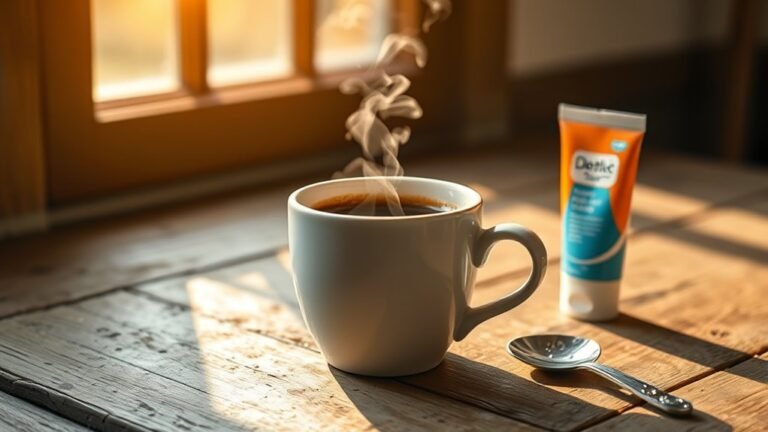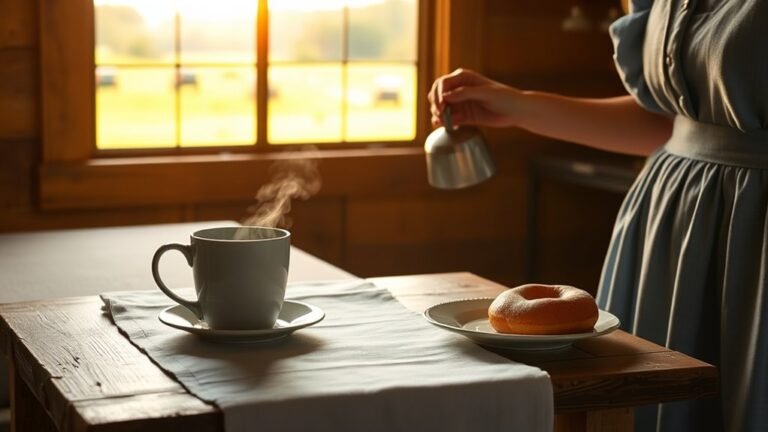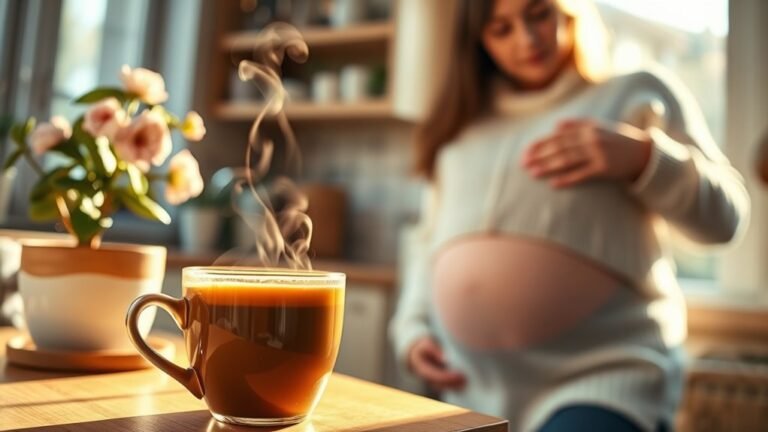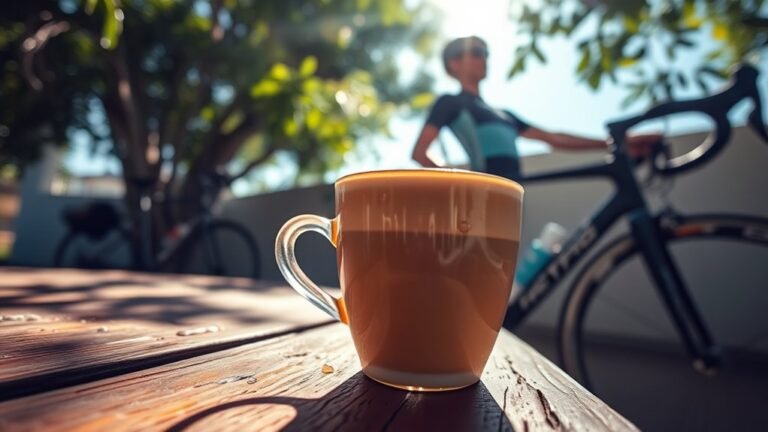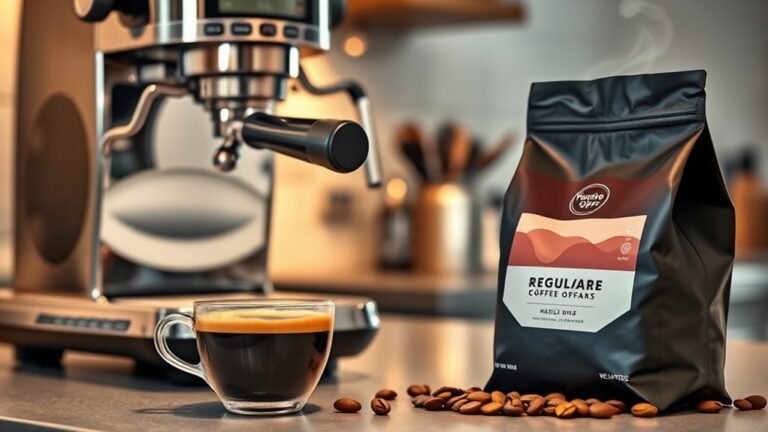The Science of Coffee Extraction: Getting the Most Flavor From Your Beans
To get the most flavor from your coffee beans, you need to control grind size, water temperature, brew time, and coffee-to-water ratio precisely. Finer grinds extract flavors faster but can cause bitterness, while coarser grinds risk sourness. Ideal water temperature ranges from 195°F to 205°F, balancing extraction speed and taste. Brew time and coffee ratios further fine-tune strength and clarity. Mastering these variables guarantees a balanced cup, with subtle nuances revealed as you explore deeper techniques.
What Is Coffee Extraction?

Coffee extraction refers to the process where water dissolves soluble compounds from coffee grounds, transforming them into the beverage you drink. This extraction varies greatly depending on coffee types—like Arabica or Robusta—each offering distinct soluble profiles. Your choice of brewing methods, whether pour-over, espresso, or French press, further influences how these compounds dissolve. You’ll notice that different methods control variables such as water temperature, grind size, and contact time, all affecting extraction efficiency. Understanding extraction means recognizing that it’s not just about dissolving solids but selectively pulling flavors, acids, sugars, and oils that define the coffee’s character. When you master this, you gain freedom to tailor your brew’s strength, clarity, and complexity, making each cup a precise reflection of your preferences.
Key Factors Influencing Coffee Extraction
You’ll find that grind size directly controls the surface area exposed to water, affecting extraction efficiency. Water temperature plays a critical role in dissolving flavor compounds, with small variations notably altering the final cup. Additionally, brew time determines how long extraction occurs, balancing under-extraction and over-extraction risks.
Grind Size Impact
Although many variables affect the final brew, grind size plays a critical role in determining extraction efficiency and flavor balance. When you adjust grind settings, you control the surface area exposed to water, directly impacting how quickly compounds dissolve. Finer grinds increase extraction speed but risk over-extraction, yielding bitterness. Coarser grinds slow extraction, potentially causing under-extraction and sourness. Achieving consistent grind uniformity is essential; uneven particles lead to uneven extraction, muddling flavor clarity. To optimize your brew, calibrate grind size precisely for your brewing method, ensuring uniform particles that promote balanced extraction. By mastering grind size and uniformity, you open up the freedom to tailor your coffee’s flavor profile, achieving a harmonious brew that highlights your beans’ unique characteristics without overpowering or underwhelming your palate.
Water Temperature Effects
When water temperature varies, it markedly influences the extraction rate and the solubility of coffee compounds, directly shaping the flavor profile you experience. Different brewing methods demand specific temperature ranges to optimize extraction without over-extracting bitter elements or under-extracting desirable flavors. Staying within an ideal temperature range—typically 195°F to 205°F—ensures balanced extraction.
Consider how temperature affects your brew:
- Higher temperatures increase solubility, extracting oils and acids faster
- Lower temperatures may yield under-extracted, sour flavors
- Espresso requires precise temperature control due to short contact time
- Cold brew uses room temperature or colder water, extracting slowly over hours
- Adjusting temperature can highlight or suppress specific flavor notes
Understanding these effects lets you tailor your brewing process for maximum flavor freedom.
Brew Time Influence
Water temperature sets the stage for extraction speed, but brew time ultimately determines how thoroughly those soluble compounds are drawn out. Adjusting brew time variations lets you control flavor balance—too short, and your coffee may taste weak; too long, and bitterness dominates. Understanding brew time recommendations for different methods empowers you to craft your perfect cup with freedom.
| Brew Method | Recommended Brew Time |
|---|---|
| Espresso | 25-30 seconds |
| Pour Over | 2.5-4 minutes |
| French Press | 4-5 minutes |
| AeroPress | 1-2 minutes |
| Cold Brew | 12-24 hours |
These precise times guide extraction completeness, helping you maximize flavor without over-extracting undesirable compounds.
The Role of Grind Size in Flavor Extraction
Since grind size directly influences the surface area exposed during brewing, it plays a critical role in determining the rate and extent of flavor extraction. If your grind consistency varies, extraction becomes uneven, leading to a muddled flavor profile. Finer grinds increase surface area, accelerating extraction, but risk over-extraction and bitterness. Coarser grinds slow extraction, potentially causing under-extraction and sourness. Mastering grind size lets you control flavor nuances precisely.
Grind size dictates extraction speed and flavor balance—finer grinds intensify, coarser grinds mellow your brew.
Consider these aspects:
- Finer grind = faster extraction, more intense flavors
- Coarser grind = slower extraction, lighter taste
- Consistent grind size guarantees balanced extraction
- Adjust grind size to match brewing method
- Variations in grind size alter acidity, sweetness, and bitterness
How Water Temperature Affects Coffee Taste
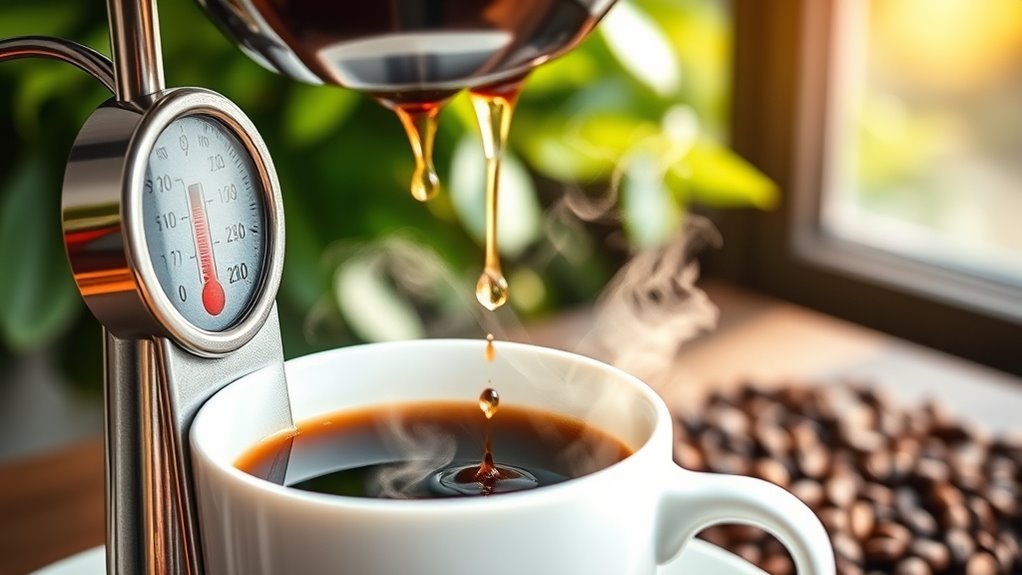
Although you might not immediately consider it, the temperature of the liquid you use dramatically influences the chemical extraction of your coffee. Water temperature governs which compounds dissolve from the grounds, directly shaping your coffee’s flavor profile. If the water’s too cold, essential aromatic oils and acids fail to extract fully, resulting in a weak, underdeveloped cup. Conversely, excessively hot water can over-extract bitter compounds and scorch delicate flavors, leading to harshness. Ideally, maintaining water temperature between 195°F and 205°F (90°C to 96°C) balances solubility, ensuring you capture the best range of flavors. By controlling water temperature precisely, you reveal the full potential of your beans, crafting a nuanced, vibrant brew that truly reflects their character.
The Impact of Brew Time on Extraction Quality
You’ll find that the ideal brew duration is critical for balancing flavor extraction and avoiding bitterness. If you let the brew time extend too long, compounds that contribute to over-extraction will dominate, leading to a harsh, unpleasant taste. Understanding how precise timing influences the chemical extraction helps you control the final cup’s quality.
Optimal Brew Duration
While brew time might seem like a straightforward factor in coffee extraction, its influence on flavor balance and compound solubility is both nuanced and critical. You need to tailor your brew duration to enhance extraction, ensuring desirable flavor profiles without losing subtle notes. Different brew techniques demand varying times, but precision is key to avoid under- or over-extraction. Consider these factors when refining your brew duration:
- Coffee grind size directly affects extraction speed
- Water temperature influences solubility of flavor compounds
- Contact time determines the concentration of acids and oils
- Brewing method (e.g., pour-over, espresso) sets time parameters
- Desired flavor intensity guides adjustment of extraction length
Mastering ideal brew duration frees you to craft coffee that truly reflects your bean’s potential.
Effects of Over-Extraction
Extending brew time beyond the ideal range can dramatically alter your coffee’s flavor profile by extracting unwanted compounds. When you let extraction run too long, those bitter flavors intensify, overshadowing the nuanced notes you initially sought. Over-extraction disrupts the acidity balance, pushing your cup toward a harsh, astringent taste rather than a bright, vibrant one. You’re fundamentally pulling out excessive tannins and other soluble solids that aren’t meant to be part of your final brew. To maintain control and preserve flavor clarity, it’s vital to monitor your brew time closely, adjusting grind size or dosage accordingly. By understanding the precise relationship between extraction duration and taste, you can avoid bitterness and keep your coffee’s acidity perfectly balanced, granting you freedom to craft the ideal cup every time.
Understanding Coffee-to-Water Ratios
Three key factors determine the quality of your brew, and one of the most critical is the coffee-to-water ratio. This ratio directly influences coffee strength and extraction balance across brewing methods. Adjusting it lets you control flavor intensity without compromising clarity.
Consider these essentials when dialing in your ratio:
- Coffee strength varies with grind size and dose.
- Brewing methods like pour-over or espresso demand different ratios.
- Too little water yields under-extracted, weak coffee.
- Excess water dilutes flavor, reducing complexity.
- Precise measurement guarantees repeatable, ideal extraction.
Common Extraction Problems and How to Fix Them
Even the most carefully measured coffee-to-water ratios can lead to disappointing results if extraction issues aren’t addressed. Over-extraction, often caused by too fine a grind or too long a brew time, pulls harsh, bitter compounds, distorting your desired flavor profiles. Under-extraction, on the other hand, results from coarse grinds or insufficient brew time, producing weak, sour notes. To fix these common problems, adjust your extraction techniques: coarsen the grind or shorten brew time to prevent bitterness; refine grind size or extend extraction to enhance sweetness and body. Pay close attention to water temperature and agitation, as both influence solubility and extraction uniformity. By diagnosing and correcting these factors, you reclaim control over your brew, revealing the full spectrum of flavors your beans have to offer.
Tips for Perfecting Your Coffee Brew Every Time
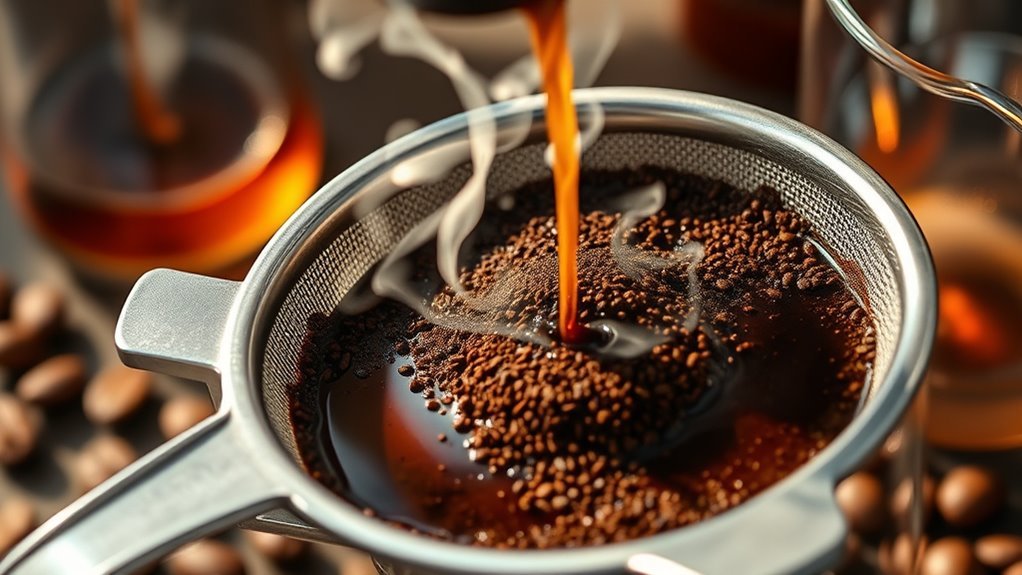
Mastering extraction challenges is just one part of brewing consistently excellent coffee. To perfect your brew every time, you need to enhance variables that influence flavor and control your process with precision. Focus on these key tips:
Master extraction and refine every variable to consistently brew exceptional coffee with precision and care.
- Choose brewing methods that suit your taste and lifestyle, from pour-over to espresso.
- Maintain coffee freshness by using freshly ground beans and storing them airtight.
- Calibrate grind size precisely to match your brewing method’s extraction rate.
- Measure water temperature accurately, ideally between 195°F and 205°F, to extract optimal solubles.
- Time your brew consistently, adjusting based on taste tests to avoid under or over-extraction.
Frequently Asked Questions
How Does Altitude Affect Coffee Bean Extraction?
Did you know coffee grown above 1,200 meters often contains more complex flavors? When you brew high-altitude beans, you need to adjust your extraction temperature since these beans are denser and harder to extract. Lower extraction temperatures around 90-92°C work best, preserving delicate acids and aromas. If you use too high a temperature, you risk over-extracting bitter compounds, losing that vibrant taste freedom you’re after.
Can Coffee Extraction Vary With Different Water Mineral Content?
Yes, coffee extraction can definitely vary with different water mineral content. When you brew, water hardness and mineral balance play essential roles in how flavors develop. Hard water, rich in calcium and magnesium, can enhance extraction by interacting with coffee solubles, but too much hardness may cause over-extraction or bitterness. Conversely, water with too few minerals might lead to flat, under-extracted coffee. You’ll want to find a balanced mineral profile to reveal the best flavors.
What Equipment Maintenance Best Improves Extraction Consistency?
Oh, sure, just toss your grinder in the corner and hope for the best! But if you’re serious about freedom in your cup, regularly calibrate your grinder for consistent particle size. Keep a keen eye on brew temperature; fluctuations sabotage flavor balance. Clean your equipment meticulously—residual oils and scale undermine precision. This disciplined maintenance guarantees your extraction’s consistency, freeing you from unpredictable brews and letting your coffee’s true character shine through.
How Do Different Coffee Bean Origins Influence Extraction Techniques?
You’ll notice that different coffee bean origins bring unique origin flavors, which demand tailored extraction profiles to highlight their best qualities. Beans from fruity East African regions often need shorter, cooler extractions to preserve brightness, while denser, chocolatey Latin American beans benefit from longer, hotter extractions to reveal deeper notes. Adjusting grind size, temperature, and brew time lets you craft precise profiles, giving you the freedom to emphasize the distinct character of each origin.
Is There a Best Time of Day to Brew Coffee for Optimal Flavor?
Think of brewing coffee like catching the perfect wave—timing is everything. While many swear by morning rituals to maximize flavor, the best time to brew depends on your body’s rhythm and preferences. Your brewing habits influence extraction quality; freshness and water temperature matter more than the hour. Freedom lies in experimenting—try different times to see when your palate perceives coffee’s nuances best, then make that your ideal brewing moment.


